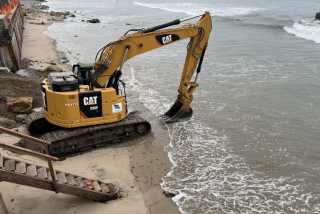10-Foot Limit Set for Beach Encroachment : Access: Newport Beach planners recommend the limit and an annual fee for property owners who have built structures on the public beach.
- Share via
NEWPORT BEACH — Oceanfront homeowners who for years have built patios and walls on public beach got a partial reprieve from the Planning Commission early Friday when it recommended that the city allow encroachments of up to 10 feet for a small annual fee.
In one of the most contentious issues to face Newport Beach officials in the last year, residents have complained that continuing the encroachments amounts to a giveaway of public land to wealthy property owners.
But others have opposed punishing homeowners for violating laws that have for decades gone unenforced by the city. They also point out that many of the questionable patios and structures were inherited from previous property owners.
“There are good people on both sides of this issue, and we are beginning to see that there is more than two sides to the issues,” said Jan Debay, head of the Planning Commission.
More than 130 people, many of whom live along the oceanfront, packed the City Council chambers for the regular commission meeting Thursday night, the second of two public hearings dealing with beach encroachment.
The final vote came at 1 a.m. Friday after five separate motions, including two that would have eliminated all intrusions on the sand and one that would have allowed them up to 15 feet.
The encroachment issue has been on the city agenda for several years. City records show that 295 out of 600 homes between the Santa Ana River and the tip of the Balboa Penisula have small walls, decks or patios on a public easement originally intended for a road.
Some walls stretch up to 27 feet beyond legal property lines. In many cases, the encroachments were built to protect homes from blowing sand. They were later landscaped or improved by adding everything from hot tubs to barbecues.
The recommendation, which passed on a 4-3 vote, now must go before the City Council and the state Coastal Commission for final approval.
If accepted, the measure will mean that homeowners must limit their encroachments to 10 feet and pay an annual fee of $50 to the city to make up for limiting public access to the beach. Of the 295 encroachments, 118 will have to rip out at least some fencing or patios to comply.
Planning Commissioner James Person, who voted against the final motion, was the most vocal opponent of the encroachments.
“Purely and simply, I don’t think private encroachments ought to be allowed on public property,” he said.
The City Council is scheduled to begin considering the Planning Commission’s recommendation Aug. 27. Public hearings on the issue are anticipated for September.
“I know that there’s going to have to be some give and take on this issue,” said Councilwoman Evelyn Hart, after hearing about the Planning Commission’s recommendation. “We’ve been sitting on this for some time now, and I think it’s about time that we bite the bullet and make some decisions.”
The Planning Commission’s recommendation is a departure from those of a city committee formed more than a year ago. That committee report, published in April, set up fees, a permit system and limits of 15 feet for encroachments.
Jerry Cobb, the committee’s former chairman, said he was disappointed with the commission’s reduction of the limit.
“I’m sure that the commission in going from 15 to 10 (feet) had sincere motives and was trying to move toward a compromise,” Cobb said. “However, what they did not appreciate was that our committee had spent a year to seek 15 feet, which was a compromise for the homeowners who would have to tear out their fences.”
Cobb also said that the five-foot difference would not matter much to people visiting the beach--where beach depth can range from 260 to 500 feet.
More to Read
Sign up for Essential California
The most important California stories and recommendations in your inbox every morning.
You may occasionally receive promotional content from the Los Angeles Times.













